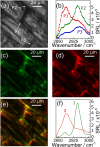Broadband stimulated Raman scattering microscopy with wavelength-scanning detection
- PMID: 33132486
- PMCID: PMC7586786
- DOI: 10.1002/jrs.5816
Broadband stimulated Raman scattering microscopy with wavelength-scanning detection
Abstract
We introduce a high-sensitivity broadband stimulated Raman scattering (SRS) setup featuring wide spectral coverage (up to 500 cm-1) and high-frequency resolution (≈20 cm-1). The system combines a narrowband Stokes pulse, obtained by spectral filtering an Yb laser, with a broadband pump pulse generated by a home-built optical parametric oscillator. A single-channel lock-in amplifier connected to a single-pixel photodiode measures the stimulated Raman loss signal, whose spectrum is scanned rapidly using a galvanometric mirror after the sample. We use the in-line balanced detection approach to suppress laser fluctuations and achieve close to shot-noise-limited sensitivity. The setup is capable of measuring accurately the SRS spectra of several solvents and of obtaining hyperspectral data cubes consisting in the broadband SRS microscopy images of polymer beads test samples as well as of the distribution of different biological substances within plant cell walls.
Keywords: coherent Raman spectroscopy; hyperspectral microscopy; nonlinear optical microscopy; optical parametric oscillators; stimulated Raman scattering.
© 2020 The Authors. Journal of Raman Spectroscopy published by John Wiley & Sons Ltd.
Figures






References
-
- Cheng J.‐X., Xie X. S., Coherent Raman scattering microscopy, CRC press; 2012.
-
- Rigneault H., Berto P., APL Photonics 2018, 3, 091101.
-
- Zumbusch A., Holtom G. R., Xie X. S., Phys. Rev. Lett. 1999, 82, 4142.
LinkOut - more resources
Full Text Sources
